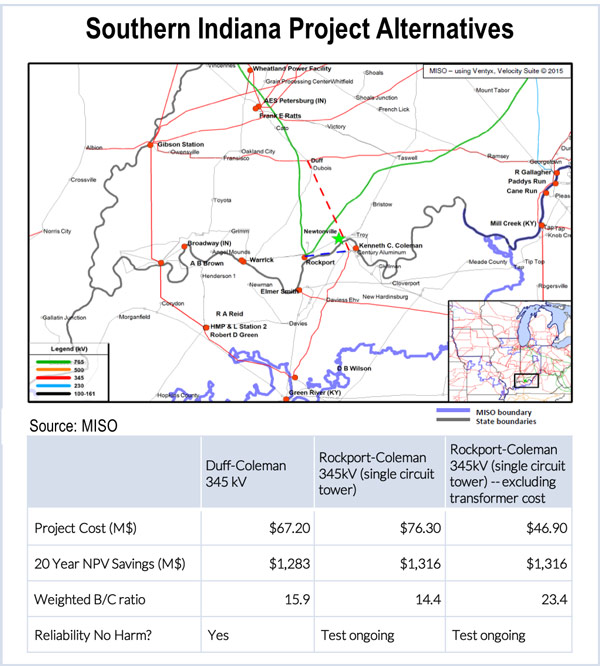
The St. Louis-based company earned $150 million ($0.61/share) compared with $149 million ($0.61/share) in the same period last year. Operating revenues were $1.40 billion versus $1.42 billion last year.
Ameren said its results were buoyed by earnings from investment in electric transmission and delivery infrastructure, along with a lower tax rate.
The company raised its full-year earnings-per-share guidance slightly, to $2.48 to $2.68 from $2.45 to $2.65.
— Chris O’Malley
Lower Revenues Dim CMS Energy Profits in Q2

The Jackson, Mich.-based parent of Consumers Energy earned $67 million ($0.25/share) compared with $83 million ($0.30/share) during the second quarter of last year. Revenue was down to $1.35 billion, from $1.47 billion a year earlier.
Nevertheless, CMS reaffirmed its 2015 earnings-per-share guidance of $1.86 to $1.89, consistent with its goal of 5 to 7% annual adjusted EPS growth.
President and CEO John Russell said CMS is still on track to retire its seven oldest coal plants — amounting to one-third of its coal fleet — by next April. The units being shuttered are an average of 60 years old and will be replaced by gas-fired units.
Russell also said CMS will proceed with its first-ever utility-scale solar generating station. The 10-MW demonstration project will be evaluated for the potential of additional utility-scale units in Michigan.
— Chris O’Malley
Unfavorable Weather Cited in DTE Earnings Drop

The Detroit-based company posted net income of $109 million ($0.61/share) compared with $124 million ($0.70/share) in the same quarter last year.
Operating earnings in DTE’s electric segment were down by $18 million, while the gas utility segment recorded a $3 million decline. Operating revenue for the company fell 15%, to $2.27 billion.
During a conference call, executives cited strong growth in the gas storage and pipeline business and in energy trading. As a result, DTE raised its 2015 operating EPS guidance to $4.54 to $4.90, from $4.48 to $4.72.
— Chris O’Malley
Eversource Q2 Earnings Jump 63%
Eversource Energy said last week that the company’s second-quarter profits this year increased by nearly 63%, from $127.4 million ($0.40/share) in 2014 to $207.5 million ($0.65/share).
“We had an excellent first half of 2015, with financial performance consistent with our targeted 6 to 8% long-term earnings growth rate and our 2015 projected earnings of $2.75 to $2.90 per share,” Eversource CEO Thomas May said in a statement.
The company also said it is reviewing the recent Department of Energy draft Environmental Impact Statement for its Northern Pass transmission project. (See Price Tag Likely to Rise for Northern Pass Transmission Line.)
“We don’t believe it poses any unanticipated challenges to the construction of the project,” said Lee Olivier, executive vice president of enterprise strategy and business development. He added that plans for site approval will be filed with state officials in “early to mid-fall,” with review taking about one year.
— William Opalka
Exelon: Quad Cities Decision as Soon as September; Awaiting Pepco Decision from DC
Exelon CEO Chris Crane told analysts during the company’s quarterly earnings conference call that if Illinois legislators fail to pass a law that would essentially guarantee profits for its nuclear plants, the company may be forced to close its Quad Cities generator, with a decision coming as soon as September.
Crane and other company officials have long said that three of its six nuclear stations in Illinois are losing money on the wholesale market, primarily because low natural gas prices are pushing wholesale power prices down.
Even anticipated revenue boosts from PJM’s Capacity Performance program “will not be enough to keep all the units economically viable,” Crane said. The decision on whether to keep its Clinton nuclear station open — which bids into MISO and therefore is governed by different rules — won’t be made until the first months of next year.
“We don’t take the decision lightly,” Crane said. “We understand the effect that we have on the communities and potential effect on employees, but this has been a long-term issue that we’ve been evaluating and trying to come to a resolution [on], and we’re staying within the timeline.”
Exelon reported second-quarter earnings of $508 million ($0.59/share) compared with $440 million ($0.51/share) this time last year.
The company said profit rose due to higher sales and a hedging-related gain. Crane also credited strong financial performance by Exelon Generation.
Crane also said the company is prepared to quickly finalize its $6.8 million acquisition of Pepco Holdings Inc., pending approval by regulators in D.C. As the company awaits the ruling, expected late this month, it extended the deal’s termination date from July 29 to Oct. 29.
Pepco’s second-quarter earnings were flat compared with the same period in 2014, with net income of $53 million ($0.21/share).
“Increased operation and maintenance costs, primarily driven by the implementation of a new customer information system, impacted second-quarter results,” CEO Joseph Rigby said.
— Suzanne Herel
FirstEnergy Beats Expectations

“We remain focused on implementing our regulated growth initiatives and our Cash Flow Improvement Project, which was launched in April,” CEO Charles Jones said in a statement. “I’m pleased that the opportunities we have identified as part of that project are expected to result in cash savings of $240 million by 2017, exceeding our original targets.”
Operating earnings for the Akron, Ohio, company’s regulated distribution business were flat compared with the same period last year, as the benefit of higher distribution revenues and approved rate cases was offset by higher operating expenses and a higher effective income tax rate.
The regulated transmission business saw higher transmission revenues, in part related to the company’s Energizing the Future plan to upgrade its grid.
The company’s competitive energy services benefited from lower operating expenses and a slightly higher commodity margin compared with last year.
— Suzanne Herel
PPL Posts Loss After Talen Spinoff
FERC Gives Conditional OK to Talen Energy.)
The company said the loss reflected a $1 billion hit from discontinued operations of the competitive supply business.
For the same period last year, PPL had reported net income of $229 million ($0.34/share).
Not taking into consideration the spinoff and some other accounting items, the utility reported second-quarter earnings of $329 million ($0.49/share), an 11% increase from adjusted earnings of $296 million ($0.44/share) for the same period in 2014.
The company also narrowed its 2015 forecast range from ongoing operations to $2.15 to $2.25 per share and increased its quarterly common stock dividend to $0.3775/share.
“Based on the strong performance of PPL’s seven regulated utility businesses in both the U.S. and the U.K., the continued rate base growth from our significant infrastructure investment and our solid business plan to grow earnings per share, we are increasing the midpoint of our 2015 earnings forecast,” CEO William H. Spence said in a statement.
“The new PPL Corp. — with its strong growth profile, a solid dividend and diverse mix of holdings — is a unique and very compelling investment option in the U.S. utility sector,” he said.
— Suzanne Herel
PSEG Q2 Earnings Up 62%

“Our businesses performed well. [Public Service Electric & Gas’] expanded investment program is successfully translating into improvements in customer satisfaction at the same time operational improvements at PSEG Power supported increased output,” CEO Ralph Izzo said in a statement.
Operating earnings for PSE&G rose to $167 million ($0.33/share) from $151 million ($0.30/share) this time last year. The company attributed the boost to an expansion of its capital program, warmer-than-normal temperatures and a recovering economy.
Meanwhile, PSEG Power reported operating earnings of $110 million ($0.22/share) compared with $87 million ($0.17/share) this time last year.
The company said the results reflect improvement in operations of its nuclear and fossil fuel generating facilities, higher prices on its hedged energy output and a drop in the cost of its gas supply.
— Suzanne Herel
WEC Energy Group Erases $0.24/Share on Integrys costs
Costs related to its June acquisition of Integrys Energy put the squeeze on WEC Energy Group’s second-quarter profits.
Milwaukee-based WEC earned $80.9 million ($0.35/share), a 39% decline from $133 million ($1.04/share) in the second quarter of 2014. Excluding the acquisition costs, which cut EPS by $0.24, WEC would have reported EPS of $0.59.
Like many northern utilities, a cooler-than-normal June crimped electricity revenues. Operating revenues declined to $991.2 million from $1.04 billion last year.
WEC’s results do not yet include the financial performance of Integrys or its subsidiaries.
— Chris O’Malley
Xcel Reports Flat Earnings for Q2
Xcel Energy reported flat profits for the second-quarter, with earnings of $197 million ($0.39/share), compared with $195 million ($0.39/share) for the same period last year.
Minneapolis-based Xcel said the results were generally in line with expectations. Though the company missed analysts’ estimates by $0.01/share, it reaffirmed its full-year earnings-per-share guidance of $2 to $2.15.
Xcel blamed unfavorable weather conditions that affected customers’ heating and cooling costs and adjustments to a rate request in Minnesota.
Second-quarter electric margins increased due to new rates and riders in various jurisdictions and a lower Public Service Company of Colorado earnings test refund. Xcel said that increase was offset by higher depreciation, a lower allowance for construction funds and higher property taxes, operating and maintenance expenses and interest charges.
Xcel’s Monticello nuclear plant is operating at full capacity, having received final Nuclear Regulatory Commission approval. The facility was uprated to 671 MW from 600 MW in 2013, at a cost of $748 million (a $0.16/share hit to profits). Xcel said its Cherokee combined-cycle plant in Colorado completed its first-fire during the quarter and is on budget and on time.
— Tom Kleckner









